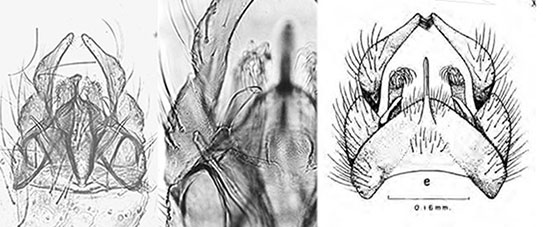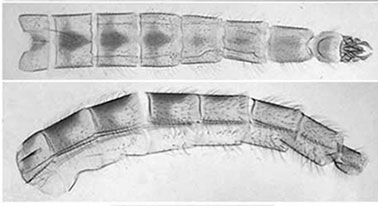Chironomus hawaiiensis Grimshaw 1901.
Synonym: Chironomus calligraphus Type 2
Possible synonym: Chironomus sp. 51 Norland et al. 1974 and others
Originally described from the U.S. state of Hawaii (for original and other previous descriptions see early descriptions), the species is now known to be much more widely distributed, including on the U.S. mainland. Specimens of C. hawaiiensis cannot be be distinguished morphologically from C. calligraphus and the COI barcodes indicated that C. calligraphus Ty. 2 is conspecific with C. hawaiiensis, which is the valid name (Martin 2020).
In BOLD Bin: BOLD:AAP1715 (as C. calligraphus)
The original descriptions can now be expanded by the inclusion of more recent specimens from Hawaii and those from mainland U.S.A.:
Male:
Wing length - 2.28-3.52 mm., width about 0.7 mm.; 3 Scf on brachiolum, about 22 setae on squamal fringe.
Head: Antennal plume with wide dark band. AR - 2.93-3.52.
Frontal tubercles about 47x16 µm; clypeal width about 0.67-0.69 of the diameter of the antennal pedicel, with about 28 setae. Palps (micron): 60 : 45 : 191 : 200 : 308; P5/P4 1.41-1.67.
Thoracic setae - Acrostichals at least 11; dorsolaterals 21; prealars 5; supra alars 1; scutellars 8 in anterior row, 10-14 in posterior row.
Leg lengths (micron) and proportions:
|
Fe
|
Ti
|
Ta1
|
Ta2
|
Ta3
|
Ta4
|
Ta5
|
LR
|
F/T
|
BR
|
PI
|
1105
|
955
|
1555
|
790
|
690
|
635
|
630
|
1.59-1.65
|
1.15-1.17
|
2-2.07
|
PII
|
1168
|
1050
|
640
|
388
|
280
|
168
|
130
|
0.59-0.63
|
1.11
|
|
PIII
|
1315
|
1215
|
993
|
518
|
405
|
260
|
160
|
0.81-0.82
|
1.08
|
|

Hypopygium (left) and Svo (center) of males from Hawaii, with figure of Hardy (1950)

Male abdomen from Huntington Beach, California (Spies et al. 2002)
Abdomen with dark, posteriorly pointed, triangular area on midline with generally fairly narrow transverse band at or near anterior margin; 5-7 setae in multiple pale patches on tergite IX. Anal point narrow, Inferior volsella with simple setae, reaching about a third along length of gonostylus which is quite expanded at the base and narrows sharply from about midpoint.
Females:
No confirmed specimens were available for study. Spies et al. (2002) recorded no significant variation between C. calligraphus and C. hawaiiensis individuals from different localities and also noted that there were no obvious differences from females of related species.
Pupa: Length 11.3 (7.8-13.3) mm. Cephalic tubercles well developed (104x63 µm) and dark.
About 101 recurved hooks on segment II, occupying about 77% of segment width; Pedes spurii A on segment IV about 103x63 µm and about 15% of the segment length, those of V-VII a field of small points.
Abdominal sternite I and II with weak shagreen of variable extent down the center of segs II-VI, on anterior of segment VII and on most of segment VIII.
Postero-lateral spur of segment VIII with 2-3 spines in one case separated like a 2-pronged fork. About 87 taeniae on each side of the swim fin.
Fourth instar larva a small to medium plumosus-type (11.4 (9.8-13.3 mm) (male 9.8mm; female 10.3-13.3). Gula dark to very dark on posterior third to half extending beyond the width of the mentum and with a level anterior margin, frontoclypeus also darkened, and sometimes some darkening just outside the frontoclypeus. Ventral tubules with posterior pair longer (Ant. 1.38 (0.92-1.76) mm; Post. 1.49 (1.08-1.82 mm)), posterior pair coiled. Lateral tubules well developed 365 (320-420) µm. Anal tubules relatively short, ventral pair longer (dors. 336.6 (280-360) µm; ventral 384.7 (351-450) µm), about 2.4-3.7 times longer than wide.
Mentum (Fig. c) with somewhat rounded teeth; c1 tooth relatively narrow and rounded, c2 teeth moderately well separated (type IIA or III), with reduced 4th lateral (type II).
Ventromental plates (Fig. d) separated by about 30 (28-34)% of the mentum width; about 182.2 (172-195) µm long and 3.6 (3.4-3.9) times longer than deep; longer 1.08 (1.06-1.13)x than the width of the mentum; with about 40.7 (39-49) striae; VMR 0.25 (0.20-0.33).
Clypeal aperture about 59 (46-68) x 16.3 (15-23) µm, l/w 3.25 (2.6-4.2).
Premandible with teeth about equal length, inner tooth about 3-4.5 times wider than outer tooth.
Pecten epipharyngis (Fig. a) with about 12.3 (10-15) somewhat irregular teeth (type B).
Distance between the antennal bases usually greater than the distance between the S4 setae, which are separated by about 81 (76-84)% of the FC width at that point.
Antenna (Fig. b) with relatively narrow basal segment, about 3.0 (2.64-3.53) times longer than wide; segment lengths (micron): 100 : 26 : 6 : 10.5 : 6 (note A3 about same length as A5 - A5/A3 0.96 (0.75-1.25)); AR about 2.15 (1.73-3.12); A2/A1 about 0.26 (0.23-0.28). Two Hawaiian specimens showed developmental abnormalities of one antenna, in one case with only 4 segments (lacking A3) and the other with only 3 segments (lacking A2 and A3).
Mandible (Fig. e) with 3rd inner tooth relatively well developed but only partly colored (mostly type IIIB, but occasionally IIIC); 14.7 (10-22) furrows on the outer surface near the base; 11.2 (10-13) taeniae in Pecten mandibularis; MTR 0.10-0.18.
Cytology: 4 polytene chromosomes with the pseudothummi arm combination AE, BF, CD, G.
Arm G relatively long, closely paired with a nucleolus about 1/4 from one end and a BR near the other end. No nucleoli in other chromosomes. Moderate amount of heterochromatin at the centromeres. Arm B with bulb and distal dark bands about 1/3 from end of arm.
Polymorphism for arms A, B, and C is present in Central or South American samples and for arm C in Hawaiian samples.
hawA1: 1a-e, 9a-e, 2d-3b, 8g-d, 1k-f, 3c-i, 13-15, 4-8c, 2a-c, 10-12, 16-19 as cagA1
hawB1: bulb (gp 7) about 1/3 from distal end with dark bands (gp 8?) distal to it. as cagB1
hawC1: Typical band group 3-4 about 1/3 from centromere. as cagC1
hawD1: not mapped. as cagD1
hawE1: 1-3e, 10b-9, 3f-8, 12b-10c, 12c-13 as cagE1
hawF1: 1-6b, 19-18, 11f-14, 17-15, 11e-6c, 20-23 as cagF1 & sp. WOC.
Confirmed localities:
Found: Hawaii - Waialua (21.575°N, 158.129°W), Koolau Range(Type locality), Bishop Museum (19.55°N, 154.77°W), Honolulu ; Enchanted
Lake (21.25°N, 158.67°W), Kailaua, all Ohau; Kealia Pond (20.78°N, 156.93°W), Kihei, Maui.
California - South Gate and Long Beach, Los Angeles River; Bellflower, San Gabriel River; N fork Coyote Creek, vicinity of Telegraph
Road, Whittier (58.97°N, 118.02°W); all Los Angeles Co.; Huntington Beach (33.640°N, 117.971°W); Santa Ana River Anaheim
(33.84°N, 53.89°W) (BOLD); all Orange Co.; Good Samaritan retirement home, Corona; Hidden Valley golf course, 2 mi. w. Pedley;
Valley Seminary District (33.71°N, 116.20°W), all Riverside Co.; San Diego (32.8263°N, 117.134°W), San Diego Co. (BOLD);
Canejo Creek (34.201°N, 119.001°W), Ventura Co. (BOLD)
also: Brazil - Belém, Pará; Tahiti (GenBank - based on barcode data).
[ Return to Index
| Go to References ]
|

